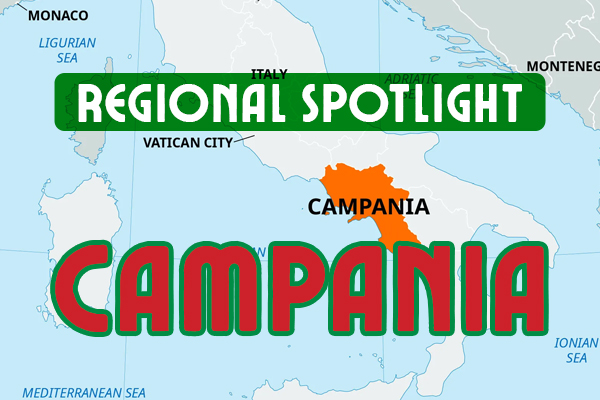Explore the vibrant region of Campania, where ancient history, stunning coastlines, and world-famous cuisine converge. From the bustling streets of Naples to the serene beauty of the Amalfi Coast, discover what makes Campania an Italian treasure.
Location and Climate
Campania is located in southwestern Italy, bordered by Lazio to the northwest, Molise to the north, Puglia to the northeast, and Basilicata to the east. The region is flanked by the Tyrrhenian Sea to the west, offering a stunning coastline that includes the famed Amalfi Coast. Key geographic features include the volcanic area around Mount Vesuvius and the islands of Capri, Ischia, and Procida.
The climate in Campania is typically Mediterranean along the coast, with hot, dry summers and mild, wet winters. Inland areas experience a more temperate climate, with cooler winters and warm summers. This diverse climate supports a variety of agricultural activities and makes Campania an attractive destination year-round.
Historical Tapestry
Campania’s history is as rich and varied as its landscape. Key historical periods include:
Ancient Greece and Rome: Campania was an important region in both the Greek and Roman periods. The Greeks established colonies such as Cumae and Neapolis (modern-day Naples), while the Romans left a lasting legacy with the cities of Pompeii and Herculaneum, which were famously buried by the eruption of Mount Vesuvius in 79 AD.
Middle Ages: During the Middle Ages, Campania was a contested region, with various powers, including the Byzantines, Lombards, and Normans, vying for control. This period saw the construction of numerous castles, fortresses, and religious buildings.
Renaissance and Baroque: The Renaissance and Baroque periods brought a flourishing of arts and culture to Campania, particularly in Naples, which became a major center of artistic and architectural development.
Modern Era: Campania played a significant role in the unification of Italy in the 19th century. Today, it remains a vibrant region known for its dynamic culture, economic significance, and tourist attractions.
Key Cities
Naples (Napoli): The capital of Campania, Naples is a bustling metropolis known for its rich history, vibrant street life, and culinary excellence. Key attractions include the Naples National Archaeological Museum, the historic center (a UNESCO World Heritage site), and the Royal Palace of Naples. The city is also famous for its pizza, with the traditional Neapolitan pizza being a must-try.
Salerno: Located on the Gulf of Salerno, this city is known for its beautiful seaside promenade, the medieval Salerno Cathedral, and the Arechi Castle. Salerno also serves as a gateway to the stunning Amalfi Coast.
Amalfi: A picturesque coastal town that gives the Amalfi Coast its name, Amalfi is known for its stunning cliffside scenery, historic architecture, and the impressive Amalfi Cathedral. The town’s narrow streets, quaint shops, and beautiful beaches make it a popular tourist destination.
Sorrento: Overlooking the Bay of Naples, Sorrento is famous for its scenic views, lemon groves, and charming historic center. Key attractions include the Piazza Tasso, the Marina Grande, and the stunning views from the Sorrento Peninsula.
Caserta: Home to the magnificent Royal Palace of Caserta, a UNESCO World Heritage site, Caserta boasts one of the largest and most opulent palaces in Europe. The palace’s extensive gardens, fountains, and baroque architecture are a must-see.
Culinary Delights
Campania’s cuisine is celebrated for its bold flavors, fresh ingredients, and traditional recipes. The region is known for its contributions to Italian gastronomy, particularly in the areas of pizza, pasta, and seafood. Key culinary highlights include:
Pizza Margherita: The iconic Neapolitan pizza, topped with tomatoes, mozzarella cheese, and fresh basil, represents the colors of the Italian flag and is a symbol of Naples’ culinary heritage.
Spaghetti alle Vongole: A classic dish of spaghetti with clams, garlic, olive oil, and parsley, reflecting the region’s coastal influence.
Mozzarella di Bufala: Made from the milk of water buffalo, this creamy and flavorful cheese is a staple in Campanian cuisine, often enjoyed fresh or used in various dishes.
Sfogliatella: A traditional Neapolitan pastry filled with ricotta cheese, candied fruit, and semolina, known for its crispy, layered shell.
Limoncello: A popular lemon liqueur produced mainly in the Sorrento and Amalfi regions, enjoyed as a refreshing digestif.
Click here to browse Recipes from the Campania Region
Agricultural Highlights
Agriculture plays a vital role in Campania’s economy, with the region producing a variety of high-quality products. Key agricultural highlights include:
Tomatoes: The fertile volcanic soil around Mount Vesuvius is ideal for growing tomatoes, particularly the San Marzano variety, which is renowned for its flavor and used in many traditional dishes.
Olive Oil: Campania produces excellent extra virgin olive oil, known for its rich and fruity flavor, which is a staple in the local cuisine.
Citrus Fruits: The region is famous for its lemons, particularly those from the Amalfi Coast and Sorrento, which are used to make limoncello and other products.
Wine: Campania boasts a rich winemaking tradition, producing notable wines such as Aglianico, Greco di Tufo, and Falanghina. The region’s vineyards benefit from the ideal climate and fertile soil.
Tourism and Major Attractions
Tourism in Campania is diverse, with visitors drawn to its historical sites, natural beauty, and cultural events. Major attractions and activities include:
Pompeii and Herculaneum: These ancient cities, buried by the eruption of Mount Vesuvius, offer a fascinating glimpse into Roman life. The well-preserved ruins include houses, temples, theaters, and public baths.
Amalfi Coast: This stunning coastline, with its dramatic cliffs, picturesque villages, and crystal-clear waters, is a UNESCO World Heritage site. Popular towns to visit include Amalfi, Positano, and Ravello.
Capri: An island of breathtaking beauty, Capri is known for its rugged landscape, upscale hotels, and shopping, as well as natural attractions like the Blue Grotto and the Faraglioni rock formations.
Royal Palace of Caserta: This grand palace, often compared to Versailles, features lavish interiors, extensive gardens, and impressive fountains. It is one of the largest royal residences in the world.
Mount Vesuvius: This iconic volcano offers hiking opportunities to its summit, where visitors can enjoy panoramic views of the Bay of Naples and the surrounding area.
Things to See and Do
Whether you’re interested in history, nature, or gastronomy, Campania offers a wide range of activities to suit all interests. Here are some top recommendations:
Explore Naples: Wander through the historic center of Naples, visit the Naples National Archaeological Museum, and enjoy a traditional Neapolitan pizza at one of the city’s famous pizzerias.
Visit Pompeii and Herculaneum: Take a guided tour of these ancient ruins to learn about the history and daily life of the Roman inhabitants before the catastrophic eruption of Vesuvius.
Drive Along the Amalfi Coast: Enjoy the stunning coastal views, stop at charming towns like Positano and Ravello, and relax on the beautiful beaches.
Tour the Royal Palace of Caserta: Explore the opulent rooms, gardens, and fountains of this magnificent palace, and learn about its history and architecture.
Hike Mount Vesuvius: Trek to the summit of Vesuvius for breathtaking views and a close-up look at the crater of this famous volcano.
Taste Local Delicacies: Sample Campanian specialties such as mozzarella di bufala, sfogliatella, and limoncello at local markets, trattorias, and pastry shops.
Conclusion
Campania, with its rich history, stunning coastline, and vibrant culture, is a region that offers something for everyone. Whether you’re exploring ancient ruins, savoring local cuisine, or relaxing on the picturesque Amalfi Coast, Campania provides an unforgettable experience. This southern Italian gem is a must-visit destination for anyone seeking to discover the diverse and enchanting charms of Italy.

